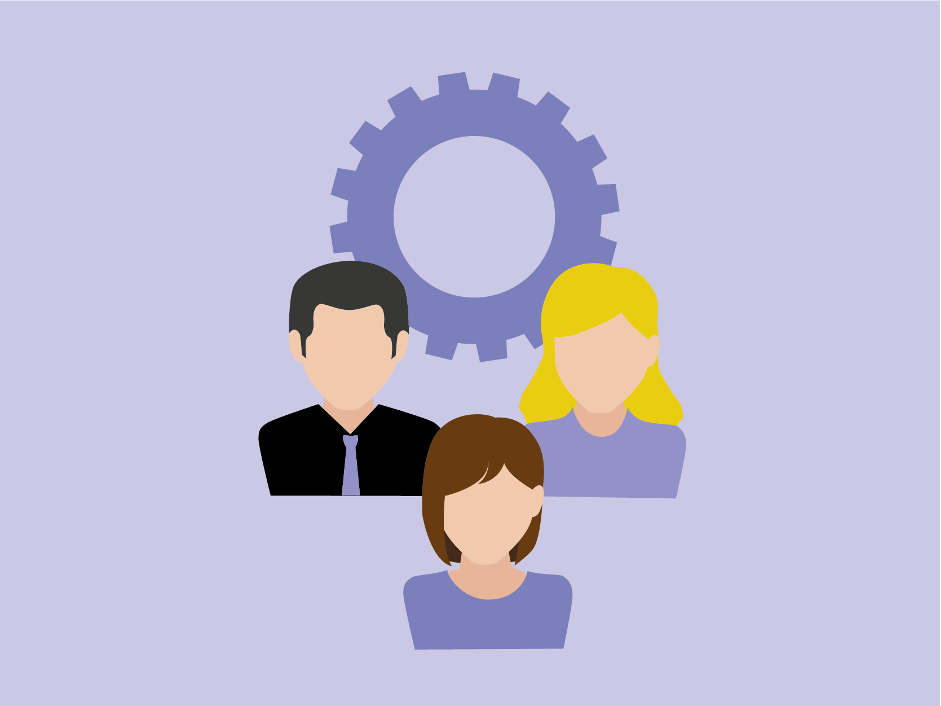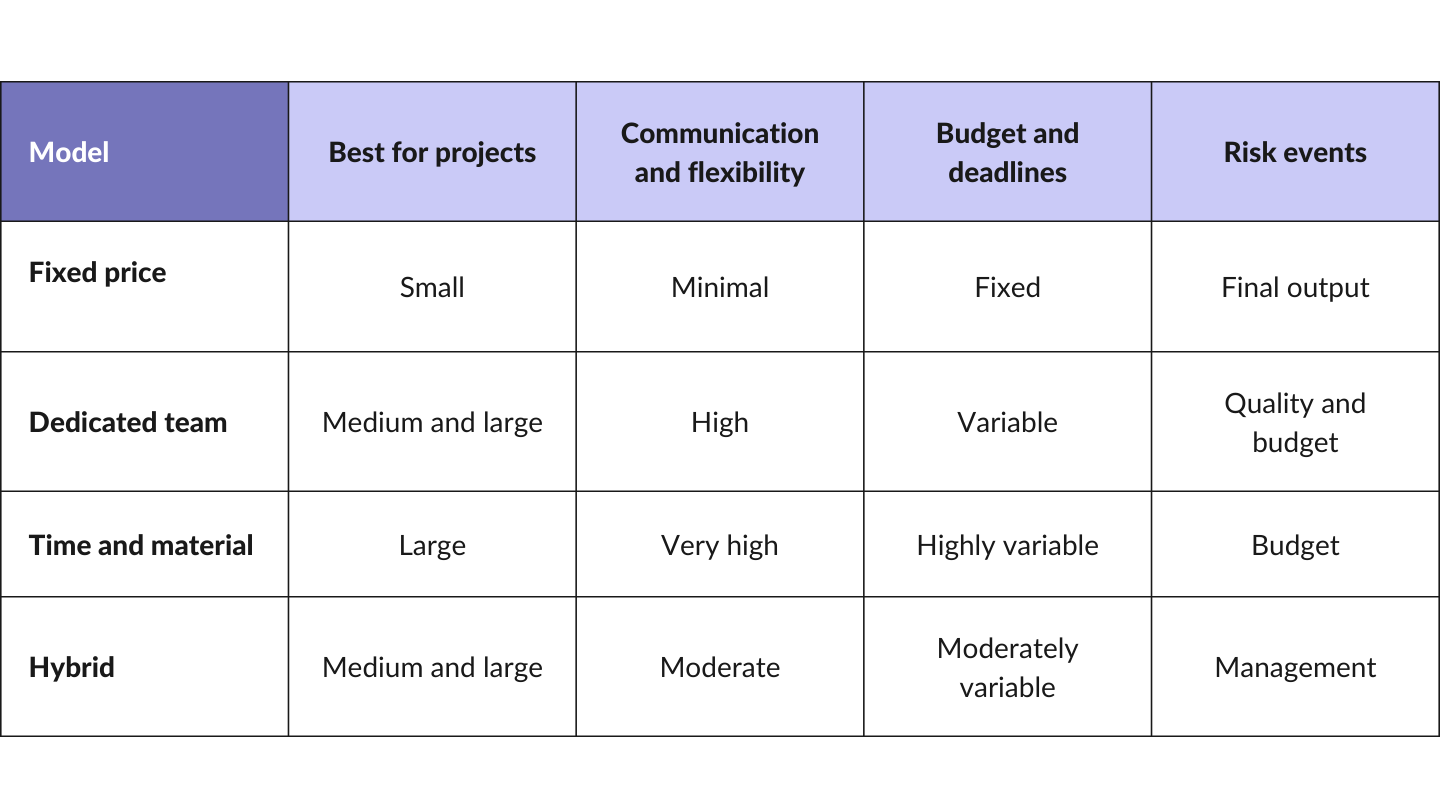An increasing number of organizations are now outsourcing their business activities to external partners, with IT services dominant among outsourced projects. GlobalViewResearch reported that the global IT outsourcing market shows a 7.7% CAGR and is forecasted to reach USD 806.63 billion by 2025.
Several cooperation models for software development outsourcing have evolved in recent years to facilitate such partnerships. However, choosing the right partnership model is important for the success of your project implementation and better ROI.
So, how can you choose the ideal software development cooperation model for your company? This article will introduce you to several cooperation models, including their pros and cons, to help you decide. Let's take a closer look!
In this post:
What to Consider Before Choosing the Cooperation Model

The specific nature of your project is one of the key elements you should consider when choosing your optimal partnership model. What works great for short-term projects with a well-defined output may not be suitable for long-term projects with varying outputs. Thus, you will need to carefully consider the degree of certainty of the output.
Additionally, the client's involvement with the development team is another key determinant. When you want your involvement to be minimal, then certain collaboration models, such as a fixed-price arrangement, would be a perfect fit. On the other hand, if you prefer active involvement, collaboration models with dedicated teams would work best.
Let’s consider what model you should choose for which project.
1. What Projects Should Use the Fixed-Price Model?
A fixed price cooperative model is most suitable for short-term projects with well-defined requirements. For example, you can easily opt for a fixed price model if you need to develop a prototype for internal use or a minimum viable product (MVP) for research.
To help you decide, we have prepared a list of questions.
- Can you clearly describe the product functionalities?
- Are you clear about the project tasks and scope?
- Can you specifically describe the implementation stages?
- Are you unlikely to make any major changes to the desired output?
- Are you comfortable delegating key project management tasks to your cooperative members?
A fixed-price model is the right one for you if the answer is “yes” for most of them. However, if you’ve answered “no” to several questions, there are two more models to contemplate.
2. What Projects Should Use the Dedicated Team Model?
The dedicated team model is a better fit for projects where requirements are not well defined. You may need to adjust the project goals over time based on customer feedback or application performance in certain projects.
If you have a dedicated team, they will easily understand the complicated scope and task requirements. You can also ask your tech partner to do outstaffing, where they take full responsibility for assembling and managing a dedicated project team. For example, Geniusee has formed and enhanced over 100 project teams globally.
So how do you know if you should form a dedicated team? If the project has many of the characteristics listed below, then a dedicated team model would serve you best.
- The project requirements are not yet clearly specified.
- The final cost is difficult to estimate.
- The project is still at an elementary stage.
- The project timeline is uncertain.
- The customer requires a lot of flexibility.
- The client will remain actively involved.
- The project involves new or untested technologies.
- The client has several tasks, but their exact timelines and scope are uncertain.
There are certain situations when neither a dedicated team nor a fixed price model will “fully” meet your project needs. If that’s the case, you should go with a time and material model.
3. What Projects Should Use a Time and Material Model?
If your project has the following characteristics, you may find the time and material model well suited.
- The end product is complex. For example, you are developing a large eCommerce website with a diverse range of products and multiple payment gateways. In addition, you are planning to scale it over time and incorporate user feedback.
- You will personally coordinate the project and the cooperative members.
- You have plans for future expansion.
- You need a dedicated development team for the project.
Now that we know the suitability of each cooperation model for different project types let’s explore the pros and cons further.
Model 1. Fixed Price
A fixed-price project always sets a clear project goal and the amount of money to be paid. Once you tell your service provider the desired outcome of the project, the provider can prepare a timeline with clear project goals.
Let’s look at the pros and cons.
Pros
- SMB suitability. It is advantageous for small and medium projects.
- Clarity. The project plan, scope, requirements and timelines are clearly defined. So there is little room for any misunderstandings.
- Low risk. As the customer will release the payment only after successful project completion, there is little risk for the customer.
- Little engagement. The tech partner will manage the project. So you don’t have to spend time and effort on management.
- No surprise. As both parties will agree on the final budget, there will be little or no surprises down the road.
- Motivation. The tech partner will remain motivated for successful completion.
Cons
- Larger efforts. You will need to invest time and resources to clearly define the project requirement. Also, a good understanding of the implementation plan is a must.
- Minimal control. As the tech partner will manage the project, you will have minimal control on the project’s operations, staffing needs, and implementation plans.
- Lack of communication. The development team will communicate less frequently with you. So, you might not be in the loop sometimes.
- Quality. As you will be out of touch sometimes, you cannot take corrective measures early if there is a quality issue.
- No flexibility. You cannot make major changes to the project requirement along the way without agreeing to pay separately.
It is essential that you get familiar with the job that will be done to make a fixed-price project successful. Familiarity with the job will help you negotiate a good price with your tech partner.
Model 2. Dedicated Team
In a dedicated-team model, the client and tech support provider agree on the workload, time, and staffing requirements. That said, the project goals and requirements may evolve. In addition, it is expected that the cooperative members of the IT service provider dedicate themselves fully to the client’s task.
The model has its pros and cons.
Pros
- Management control. You will have full control over the selection and operations of the dedicated team.
- Frequent communication. Everyone on the team will remain on the same page.
- Flexibility. You can modify the work requirements anytime based on the project needs.
- Connection. The external team members will form a good working relationship with your internal core staff.
- Team cohesion. As the team members will be dedicated to you, they will consider your success their own.
Cons
- Expensive. Typically for shorter projects, the model is more expensive than the fixed-price model.
- Longer kick-off period. It will take longer to get the project rolling because you will need to invest time and effort in selecting the team members.
- Slow learning curve. As the project team members will only work on your project, they will find it difficult to gain broader knowledge and industry exposure.
- Great effort. You must invest time and effort in project management and smooth operations.
This model is highly suitable for long-term projects. For instance, Geniusee formed a 12-member dedicated team for Drum, a bio linking mobile app, and the partnership has been working for two years.
Model 3. Time and Material (T&M)
The T&M cooperation model is comparatively simpler than the dedicated-team model. Here the customer pays for all working hours and provides all the cost of materials regardless of the project requirement or duration.
There are certain pros and cons for this model as well.
Pros
- Simpler calculation. As you will pay per hour regardless of the tasks, it will be easier to calculate and operate.
- Workflow adjustment. You will fully control the workflow and can modify it to suit the project’s needs.
- Flexibility. Your flexibility will be at the maximum among all the models.
- High quality. As the contractors will be paid for the hours worked, they will ensure quality without cutting corners.
Cons
- Time charges. The contractor may be tempted to log extra hours than the actual requirement.
- Vague requirement. The requirement may not be apparent to all parties, and communication gaps may occur.
- Cost variability. As it is difficult to predict the time requirement accurately, the cost may often be variable, causing discomfort.
The T&M model is also suitable for longer-term projects.
Model 4. Hybrid Model
The hybrid pricing model lets you combine the T&M and fixed-price model. Here’s an example. You will form two teams. One will take care of administration, business analytics, and customer relationship management. As the tasks vary, you may go with T&M for this team. Another team will take care of product development, a clearly-defined task. So you can opt for a fixed-price model for the second team.
Pros
- Finances. The hybrid model lets you take advantage of both models. So, it is financially more profitable, and you can have flexibility with payments.
- Risks. By combining both models, you can negate the risk factors of both.
Cons
- Applicability. The hybrid model is not suitable for short- and medium-term projects.
- Complications. Project management will be more complicated as you implement two separate teams.
Comparing the Pros and Cons
The table below summarizes the pros and cons of each model.

By now you can see that each model has its individual pros and cons. However, the applicability fully depends on your business, project, and requirement type. Thus, always carefully analyze the nature of the project before choosing one of the collaboration models.
Consider Geniusee Your Trusted Partner

Geniusee supports cooperation with businesses from different industries and has completed over 100 IT projects for clients located in different parts of the world. Depending on the size of your organization and your business needs, the Geniusee team can assist you with project estimation, propose the optimal cooperation model, and form your remote team.
The vetted IT experts can perform every task, from conceptual modeling to providing technical support to your end-users. The cooperative members of the dedicated team will work consistently for your custom software development and product improvement while preparing updates for the next release. Silibrain, a digital healthcare app that partnered with Geniusee, was selected as the Best Patient Engagement Solutions Software Provider for 2021 by New World Report.
Let’s take a quick look at what Geniusee offers:
- discovery phase for detailed product overview in two weeks;
- MVP for startup and business in two-three months;
- cloud solutions implementation;
- user-centered product design;
- proof of concept (POC) based on analytics & modeling;
- web / mobile product development;
- client care, maintenance, and support; and
- legacy re-engineering services.
Check out Geniusee’s portfolio for further details on successful projects.
Final Words
Choosing the right IT partnership model will help you achieve your IT product development and business goals. Your choice will depend on the project type and predictability of time and resources.
A pricing system that has worked well for a particular business and a tech support provider may not always suit your project. Thus, always consider the specific nature of your project and business. Reach out to Geniusee if you need professional assistance.





















